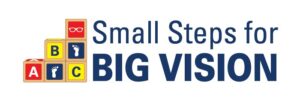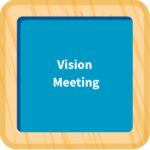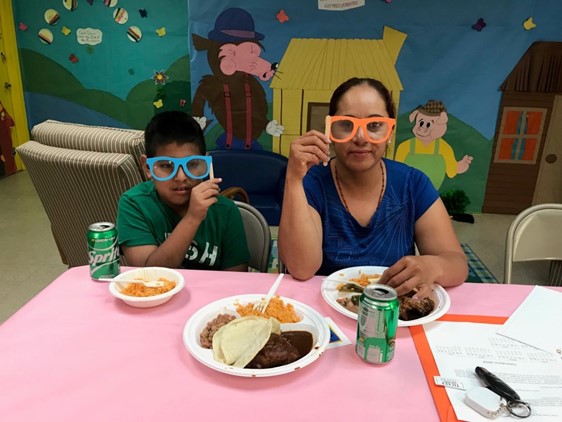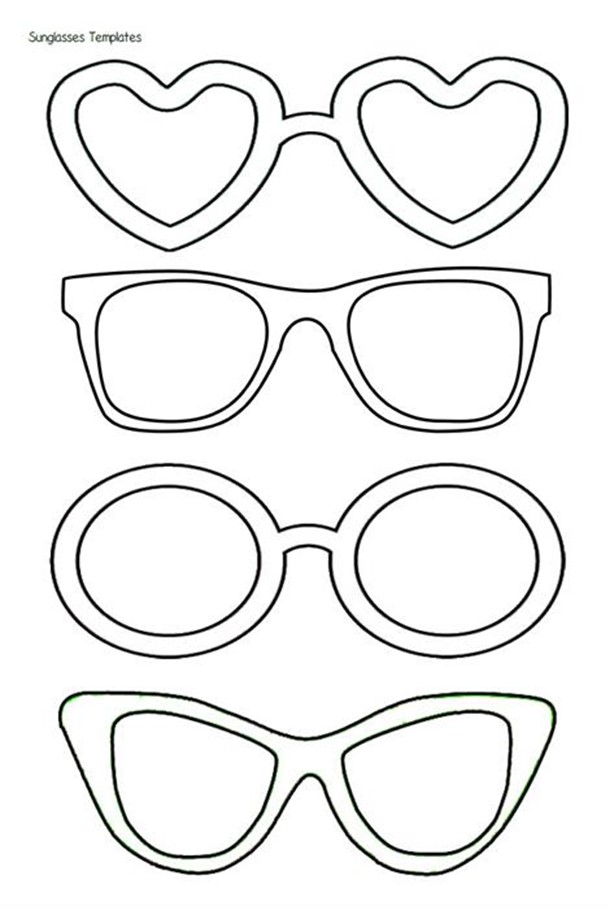


- Some parents/caregivers receive a referral for an eye examination for their children after vision screening but do not arrange and attend an eye exam because they do not think their children have a vision disorder.
- Small Steps for Big Vision provides four activities to help parents/caregivers to better understand how a child with a vision disorder may see their world, especially when parents/caregivers do not think their child has a vision problem.
- Choose one or more activities to use during the Group Vision “Play Time” Activity slide in the Small Steps for Big Vision PowerPoint presentation as part of your Parent/Caregiver Social/Meeting.
Blurred Vision Activity #1
Materials Needed:
- One or two packages of plastic wrap (e.g., Saran Plastic Wrap)
- Number of packages of plastic wrap will depend on the number of parents/caregivers attending the meeting
- Scissors
- Eye chart
- Children’s books for parents/caregivers who do not have a cell phone
- 1 book per parent/caregiver
- Number of books needed will depend on the number of parents/caregivers who do not have a cell phone
- 1 book per parent/caregiver
What to do BEFORE the Social/Meeting:
- Pull plastic wrap from the role about 12 inches in length for each participant.
- Fold the plastic wrap in half, lengthwise, 3 times, for thick, 2-inch strips.
- Distribute one 2-inch strip to each parent/caregiver only when you show the Group Vision “Play Time” Activity slide.
What to do DURING the Group Vision “Play Time” Activity:
DO THIS FIRST
- Distribute plastic wrap strips.
- Explain to parents/caregivers that you are going to pretend to screen their vision so they can experience blurred vision when trying to identify optotypes on the eye chart.
- Hold an eye chart 10 feet from the parents/caregivers.
- Ask parents/caregivers to place the folded plastic strips over their eyes.
- Ask parents/caregivers to close their left eye while keeping the right eye open (strip remains over both eyes).
- Ask parents/caregivers to name or read the last symbol or letter of each line on the right side of the chart from the top line down until they cannot identify the symbol or letter.
- Repeat the process with the right eye closed, left eye open, and ask parents/caregivers to name or read the first symbol or letter of each line on the left side of the chart from the top line down until they cannot identify the symbol or letter.
- (Note: you would never use this occlusion method during an actual vision screening. You are asking parents/caregivers to use the plastic strips and close one eye at a time only for the “Play Time” activity.)
DO THIS SECOND
- Continue holding the eye chart 10 feet away from the parents/caregivers.
- Ask parents/caregivers to pull the plastic wrap away from their eyes.
- Show the 20/32 line, explaining they should be able to correctly name at least 3 of the 5 optotypes on the 20/32 line if they are aged 6 years and older, according to national guidelines.
- Ask parents/caregivers to cover their eyes with the plastic wrap and, with both eyes open, name or read the 20/32 line on the eye chart.
DO THIS THIRD
- Ask parents/caregivers to do the following:
- Pull the plastic strips away from their eyes and place the strips near them to use during this part of the activity.
- Get out their cell phone or choose a book.
- Pull up a text message or a photograph on the screen of their cell phone or open the child’s book to a random page.
- Cover their eyes with the folded plastic strip.
- Close their left eye, while keeping the right eye open, and silently read the text message, look at the picture, or silently read the words on a page in the book.
- Close their right eye, while keeping the left eye open, and silently read the same text message, look at the same picture, or silently read the words on the same page of the book.
- Remove the plastic strip from their eyes and place it on the table in front of them or, for safety reasons, give the plastic strips to you if babies or children are nearby.
DISCUSSION AFTER THE 3 ACTIVITIES
Move to the “Talking About ‘Play Time’ – Group Vision Activity” slide.
- Ask parents/caregivers these questions:
- Was it easy or difficult to see clearly?
- Were you uncomfortable or frustrated as you tried to see clearly?
- How would blurred vision impact your daily activities?
- How might blurred vision impact your children’s learning and daily activities?
- What could parents/caregivers do to help ensure they can see clearly? (You want to receive answers about going to an eye doctor, receiving a treatment plan [such as wearing prescription glasses], following the treatment plan, and returning to the eye doctor for follow-up visits. If you do not receive these answers, provide these answers as suggestions.)
- What could parents/caregivers do to help ensure their children can see clearly? (You want to receive answers about taking their child to an eye doctor if they receive a vision screening referral, following eye doctor’s treatment suggestions [such as wearing prescription glasses], following the treatment plan, and taking their child to the eye doctor for follow-up visits. If you do not receive these answers, provide these answers as suggestions.)
DO THIS AFTER DISCUSSION AND BEFORE MOVING TO NEXT SLIDE
- Collect plastic strips after you complete the activity (if you did not collect the plastic strips before moving to the discussion slide).
- Immediately dispose of plastic strips, ensuring children have no access to the plastic wrap strips.
Blurred Vision Activity #2 – Vision Simulator Glasses (two sets of glasses for each participant with an opening for the right eye in one set and an opening for the left eye in the other set)
Materials Needed:
- Overall Blur glasses. (One vendor – Good-Lite: https://www.good-lite.com/Details.cfm?ProdID=766&category=27&Secondary=110 Product # 200766)
- Eye chart
- Children’s books for parents/caregivers who do not have a cell phone
What to do DURING the Group Vision “Play Time” Activity:
- All parents/caregivers put on a set of simulator glasses.
- If parents/caregivers are wearing prescription glasses, parents/caregivers place simulator glasses over the prescription glasses.
- Hold the eye chart 10 feet from parents/caregivers.
- Ask parents/caregivers, with both eyes open, to read the last optotype on the right side of the chart beginning with line 20/50 down to 20/20.
- Next, ask parents/caregivers to read a text message from their mobile phone or text from a random page in a children’s book.
- Ask parents/caregivers if they are having difficulty seeing clearly.
- Discuss how blurred vision could impact their children’s learning and daily activities.
- Discuss what parents/caregivers could do to help ensure they can see clearly. (You want to receive answers about going to an eye doctor, receiving a treatment plan [such as wearing prescription glasses], following the treatment plan, and returning to the eye doctor for follow-up visits. If you do not receive these answers, provide these answers as suggestions.)
- Discuss what parents/caregivers could do to help ensure their children see clearly. (You want to receive answers about taking their child to an eye doctor if they receive a vision screening referral, following eye doctor’s treatment suggestions [such as wearing prescription glasses], following the treatment plan, and taking their child to the eye doctor for follow-up visits. If you do not receive these answers, provide these answers as suggestions.)
Blurred Vision Activity #3 – Make Your Own Occluder Glasses
Materials Needed: –
- Foam core sheets in different colors or heavyweight poster board in different colors
- A pair of eyeglasses or sunglasses to use as template OR glasses template from page 6
- Non-glare sheet protector (NOT glossy)
- If you cannot find matte sheet protectors locally, find them here: https://www.amazon.com/Samsill-Non-Glare-Standard-Protectors-Reinforced/dp/B07732Z4RQ/ref=sr_1_6?crid=146U9UWWFB9R5&dchild=1&keywords=matte+sheet+protectors+8.5+x+11&qid=1592225526&sprefix=matte+sheet%2Caps%2C149&sr=8-6
- Craft sticks
- Scissors
- Glue gun (if using foam core sheets) or glue stick (if using heavyweight poster board)
- Pencil
- Eye chart
What to do BEFORE the Social/Meeting:
- Using the eyeglasses or sunglasses, trace around 1 set of glasses with a pencil on the foam core sheet or heavyweight poster board.
- Cut along the tracing lines around the glasses.
- Cut out a circle from both sides of the foam core sheet or heavyweight poster board “glasses” where lenses would be in regular glasses.
- Cut out one circle from a non-glare sheet protector to cover one of the open circles on each set of “glasses” (non-glare sheet protector sheet circles will be slightly larger than the open holes in each set of glasses).
- Glue the non-glare sheet protector circles to one open circle inside each set of glasses.
- Allow sufficient time for glue to dry.
- Glue a craft stick at one of the sides of the frame so parents can hold the glasses against their eyes.
- Allow sufficient time for glue to dry.
- Distribute the glasses when you show the Group Vision “Play Time” Activity slide.


What to do DURING the Group Vision “Play Time” Activity:
- Parents/caregivers may do this activity either with their prescription glasses on or off.
- If glasses stay on, place glasses over the prescription glasses.
- Hold the eye chart 10 feet from parents/caregivers.
- Ask parents/caregivers to cover their left eye with the “glasses” and read the last optotype on the right side of the chart beginning with line 20/50 down to 20/20.
- Turn the glasses over so the right eye is covered.
- Ask parents/caregivers to read the first optotype on the left side of the chart beginning with line 20/50 down to 20/20.
- Ask parents/caregivers if they are having difficulty seeing clearly.
- Discuss how blurred vision could impact their children’s learning and daily activities.
- Discuss what parents/caregivers could do to help ensure they can see the eye chart clearly. (You want to receive answers about going to an eye doctor, receiving a treatment plan [such as wearing prescription glasses], following the treatment plan, and returning to the eye doctor for follow-up visits. If you do not receive these answers, provide these answers as suggestions.)
- Discuss what parents/caregivers could do to help ensure their children see the eye chart clearly. (You want to receive answers about taking their child to an eye doctor if they receive a vision screening referral, following eye doctor’s treatment suggestions [such as wearing prescription glasses], following the treatment plan, and taking their child to the eye doctor for follow-up visits. If you do not receive these answers, provide these answers as suggestions.)
Blurred Vision Activity #4 – Role Play (this activity depends on the number of attendees and available eye charts)
Materials Needed:
- Homemade “occluder glasses” from Activity 3.
- If you do not have homemade occluder glasses, parents/guardians may cover each eye with their hands cupped (you would NEVER use hands to cover the eyes during actual screening for participants of any age).
- Distance Eye charts
What to do DURING the Group Vision “Play Time” Activity:
- If using homemade occluder glasses, give one set to each participant.
- Divide parents/caregivers in pairs or groups to share eye charts, depending on the number of eye charts you have available.
- Give each pair or group an eye chart.
- Ask one parent/caregiver to be the “screener” and the other to be the “child” being screened.
- Allow 10 feet between the chart and the “child” being screened.
- Depending on the number of “screener” and “child teams”, you can either measure 10-foot “lanes” with masking tape before the social/meeting or approximate the 10-foot distance during the social/meeting.
- Ask each “screener” to screen vision of the “child”, one eye at a time beginning with the right eye open and the left eye covered.
- Ask the “child” to read each letter or symbol at the end of each line on the right side of the chart.
- Start with the top line and name each symbol or letter until the “child” cannot name a symbol or letter.
- Turn occluder glasses around to show right eye closed and left eye open or ask “child” to cover the right eye with a cupped left hand.
- Ask the “child” to read each letter or symbol at the beginning of each line on the left side of the chart until they cannot name the letter or symbol.
- Switch roles and follow the same process.
- Ask parents/caregivers to return to their seats.
- Show the 20/32 line, explaining they should be able to correctly name at least 3 of the 5 optotypes on the 20/32 line.
- Discuss their challenges to seeing the 20/32 line clearly.
- Discuss how blurred vision could impact their children’s learning and daily activities.
- Discuss what parents/caregivers could do to help ensure they can see the eye chart clearly. (You want to receive answers about taking their child to an eye doctor if they receive a vision screening referral, following eye doctor’s treatment suggestions [such as wearing prescription glasses], following the treatment plan, and taking their child to the eye doctor for follow-up visits. If you do not receive these answers, provide these answers as suggestions.)
- Discuss what parents/caregivers could do to help ensure their children see the eye chart clearly. (You want to receive answers about going to an eye doctor, receiving a treatment plan [such as wearing prescription glasses], following the treatment plan, and returning to the eye doctor for follow-up visits. If you do not receive these answers, provide these answers as suggestions.)
